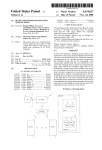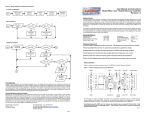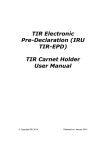Download Electronic Parachute Deployment System
Transcript
Michigan State University Electronic Parachute Deployment System User Manual May 20rd, 2014 Design Team Members: Michikazu Aono Max Cooper Zane Crawford Pedro Rodriguez Jessica Shelby The Electronic Parachute Deployment (EPD) system is an affordable and stable solution to your rocket recovery needs! The small design can fit in many different payloads of medium and large payloads, yet is light-‐weight to avoid interference with the trajectory of the rocket’s flight. This device is designed to work with deployment charges that rely on some current to deploy the charge. WARNING!! Many deployment charges are made with black powder or a black powder substitute. Please use caution when handling the charges. This is especially true when connecting the charges to the EPD system and transporting the charges. Compatibility Power Supply: The power supply suggested for the EPD system is a 9V battery. However, due to the design of the device, the voltage for the supply can be between 7V and 40V. Therefore, modification can be made to use a different battery if necessary. Also, the user can use a 9V battery for many launches before the battery is unusable. It is suggested that the power supply used be above 7.2V to avoid the voltage dropping below the usable range after use. The power supply also needs to be able to supply enough current to the deployment charges (see below for current). Deployment Charges: The EPD system is designed primarily to ignite a black powder charge the separate rocket stages. In order to ignite the powder, most igniters rely on a current to ignite. The EPD system connects the igniter to the power supply. In order to trigger the charge, the current provided must be at or above the all-‐fire current for the igniter. 𝐼≈ 𝑉!"#$%_!"##$% 𝑅!"#!$%& Setting up your EPD system What you will need: -‐ -‐ 9V battery Deployment Charges (2) Setup: 1. Attach the battery to the EPD system. Make sure the LED comes on to indicate it is receiving power. 2. Secure the EPD system and battery inside the rocket’s payload section. Failure to do so can cause damage to the EPD system and the rocket. It may also jeopardize the functionality of the EPD system. 3. Place the wires for the deployment charges in the correct position for your rocket. 4. Connect the deployment charges to the proper wires At this point, the rocket is armed and should be ready for launch. The EPD system has been proven to not misfire on the launch pad or while setting up the rocket. However, caution should be taken around any system that uses explosives and combustible material. Getting your EPD system Retrieval: 1. Disconnect the deployment wires if they are connected to some fixture or move them to make removal of the EPD system easier. 2. Remove the EPD system including battery from the payload of the rocket. 3. Listen to the flight data (optional). 4. Remove the battery to turn the system off or press the reset button to prepare the system for another launch. Flight Data: The EPD system includes a buzzer to report three heights: the maximum height of the flight, the height the drogue parachute deployed, and the height the main parachute deployed. The heights are in units of feet. The buzzer will continue to report the data until the system is reset or deactivated (by removing the power supply). Before a measurement is announced, the buzzer will make one to three short beeps to signal that it is beginning a new number. The reading itself are the digits of the height, with a series of medium length beeps with short intervals between representing numbers 1-‐9 and a long beep to denote zero. Slightly long pauses are taken between digits. Table of buzzer codes Type of Beep 1 short beep 2 short beeps Diagram Value/description Maximum Height Drogue parachute deployment height 3 short beeps 1-‐9 medium beeps 1-‐9 1 long beep Main parachute deployment height 0 Example: A rocket launch has the drogue parachute deployed at 1203 ft. The buzzer output will have pulses of the following form:

















